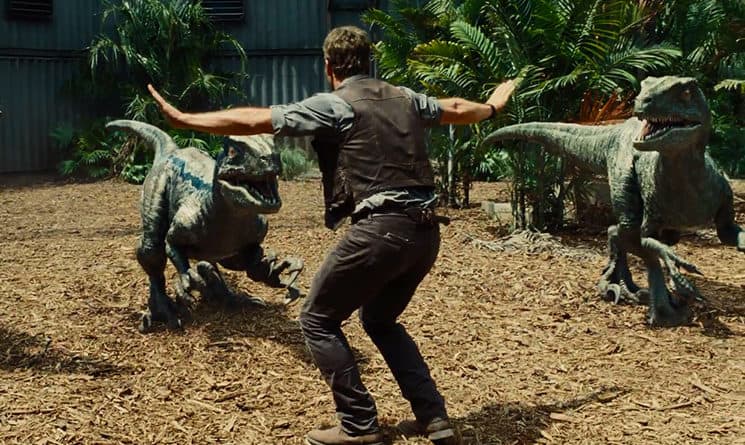Few things are more excruciating than watching a half-wit attempt to act smart. It’d be bad enough if it was just Chris Pratt we were shown failing to pull this off, treading water as best as he can in “Jurassic World,” as a charming rogue with an improbable talent for training rambunctious reptilian predators. But it’s quite a bit worse that this entire endeavor depends on a sophomore director wrestling to duplicate the work of a bona fide master.
Colin Trevorrow, who has only one decidedly low-budget indie feature film (“Safety Not Guaranteed”) under his belt, has clearly been given the mandate to expand the core concepts of Steven Spielberg’s initial “Jurassic Park,” going so far as to even include a line of dialog that simply must have been lifted from a pre-production meeting: “Consumers want them louder, bigger, more teeth.” OK, on this, he delivers, but his effort is in no way expansive. If anything, it succeeds only in making everything denser.
He is in way over his head trying to live up to Spielberg’s standard. His unfortunate stab at aping the master’s work never reaches any kind of novelty, lacks even a basic understanding of the tropes he’s deploying, and barely functions as a cautious, over-calculated regurgitation. It’s as if he dusted off his old box of “Jurassic Park” trading cards, shuffled them, and tacked them up at random and called it a storyboard. Once again, a pair of young siblings (this time brothers) is consigned to the care of the island theme park’s administrator — now an aunt (Bryce Dallas Howard) instead of a grandfather, but still sporting a snappy white outfit, in case you missed the reference. Once again, containment is breached by a big beastly bioengineered Killosaur, and once again, all hell breaks loose as everyone runs hollering around the steamy jungle landscape getting munched, crunched, and wrunched. We have scenes from a control room that’s incapable of controlling anything. We have corporate sleazebags trying to co-opt the science for terrible purposes, and even a red flare for Tyrannosaurus distraction. There’s a pack of hoodlum Velociraptors, naturally. At one point there’s even a Gallimimus stampede, for no other reason than to say, “Remember that Gallimimus stampede from the first one? That was pretty cool.” That it was. This is not. There’s no wonder here, no discovery. This exercise is painfully self-aware and even trades on it, blustering explicitly about what a terrible idea it is to simply re-constitute old creations — and then it does exactly that.
In replicating so many of the details of the first movie, they’ve neglected the heart of what made it special.
“Jurassic World” could earn some forgiveness if at least the characters had something new to offer. But, sadly, the humans on screen are, at their best, the most banal Hollywood stereotypes, and, at their worst, downright insulting. Pratt’s unidimensional dudebro hero has roughly one expression throughout. Even sad trombones have three notes. And then there’s Howard’s role as a tightly wound executive. Presented at first as a successful, super-competent, and self-actualized woman in charge of a multi-billion dollar enterprise, through the course of her adventure we’re led to understand that what she really needed all along was a good strong man to put her in her place, and possibly, it’s implied, provide her with some babies of her own to look after. As the central character arc of the film, and arriving so closely on the heels of the compelling portrayal of feminist empowerment in “Mad Max: Fury Road,” this message is jarringly wrong-headed, and just might be the movie’s most genuinely prehistoric element.
The execution is technically slick, the effects are predictably top-notch, and the camera work employs many of Spielberg’s favorite visual tricks. But someone might want to explain to the “Jurassic World” team that imitation is a failure of imagination. Parrots make for poor storytellers. In replicating so many of the details of the first movie, they’ve neglected the heart of what made it special.
For one thing, the original movie was, well, original. It was bursting with the energy of the most modern scientific and paleontological theories of the time, and thoroughly crashed the popular perception of how dinosaurs may have looked, behaved, and interacted with their world. Writer Michael Crichton, well known for placing his stories about 20 minutes ahead of the cutting edge of contemporary science journals, dazzled audiences by portraying the beasts with previously unheard of color, speed, and intelligence. Coupled with the unprecedented collusion of computer imagery and practical effects, the thing completely rewired a generation’s impression of how these creatures could once have ruled the earth.
Trevorrow appears so preoccupied with ideas that Crichton and Spielberg brought forward 22 years ago that he deliberately turns his back on the gargantuan amount of new information that has been gathered about these animals since, and possibly because of, that movie. With the data at his fingertips now, Trevorrow could easily have, for example, been the first to present a fully realized and engaging vision of extravagantly feathered dinosaurs flocking in for a kill. He really could have pushed out into new and unexplored territories, and provoked a whole new generation to ask, and possibly answer, a raft of fresh questions — like “Jurassic Park” did. But no, in his “World,” it’s enough to color inside old lines. As long as you color loudly, fast, and with more teeth.
A wise man once said: “You stood on the shoulders of geniuses to accomplish something as fast as you could, and before you even knew what you had, you patented it, and packaged it, and slapped it on a plastic lunchbox.” Indeed. Maybe Trevorrow misplaced his Ian Malcolm trading card.

